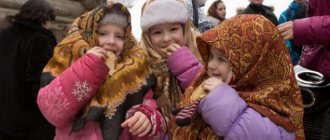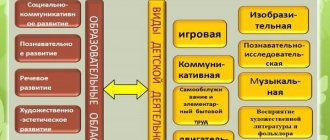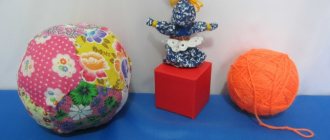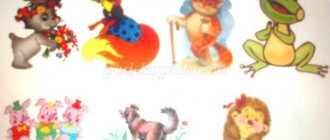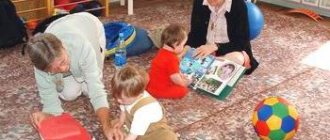taken from botan.cc
Russian folk tales have always amazed us with their simplicity and, at the same time, deep meaning. Each of them carries something special, something that makes you think and learn useful lessons. Remember how in childhood each of us was read folk tales. Children love such works very much, so performances based on them are often staged in kindergartens. Today we offer you scripts for two Russian folk tales - “Kolobok” and “Turnip”. The second tale is slightly changed to add a bit of originality and intrigue the audience.
Theatrical activities. Scenarios in the middle group
Summary of a lesson on speech development in the middle group with elements of theatricalization "On fairy-tale paths" Summary of a lesson on speech development in the middle group with elements of theatricalization "On fairy-tale paths"
Summary of the educational activity
"Speech development"
in the middle group with elements
of theatricalization Topic : "On fairy-tale paths "
(integrated. Goal: Creating favorable conditions for creativity.
Summary of a lesson on the basics of life safety in the form of a dramatization “If you are lost” (middle group) Purpose: Explain to children which adults they can turn to for help if they are lost on the street (in a store, in a crowded place. Prevent children from contact with strangers .Promote the development of caution, prudence.Develop the ability to navigate.
Publication “Easter dramatization “Masha and the Bear” (middle. » Easter dramatization “Masha and the Bear” Presenter: At the edge of the forest there was a small house, and Grandfather and Baba lived in it, and they had a granddaughter Mashenka. Grandfather: So Easter is approaching "Leave the oven, old woman! The eggs need to be painted. It's time to bake the Easter cakes! Grandmother: Granddaughter, go to the forest.
Scenario for dramatization of the fairy tale “Teremok” in the middle group. Open demonstration of organized educational activities on speech development through theatrical activities in the middle group. Dramatization of a fairy tale: “Teremok” Educational areas: “Social-communicative”, “Speech development”, “Cognitive development”, “Physical.
Re-enactment of the Easter tale "Masha and the Bear" in the middle group

Hello dear colleagues, friends! Today you can find a lot of new and interesting things on the Internet. And recently I came across the fairy tale “Masha and the Bear”, but not the simple one that we usually know, but an Easter one. The guys and I decided to beat her, and this is what we have.
Article “Summary of a lesson on theatrical activities “Teremok” for children. »
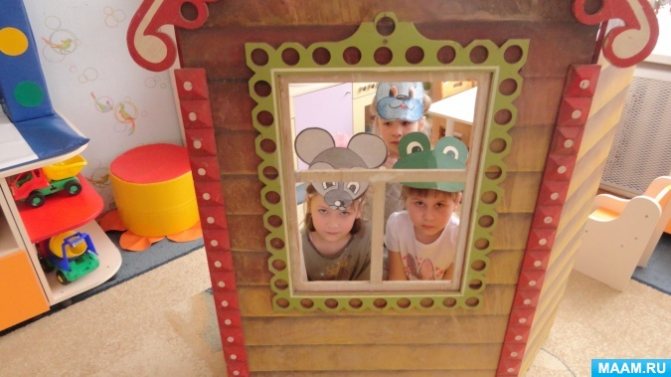
Summary of a lesson on theatrical activities “Teremok” for children 3-4 years old Educator: Nasedkina N.A. Goal: To contribute to the development of children’s ability to reflect some game actions and imitate the actions of characters, to convey simple emotional states.
Synopsis of a theatrical educational activity for children 4–5 years old “Culture and tradition of the peoples of Dagestan”
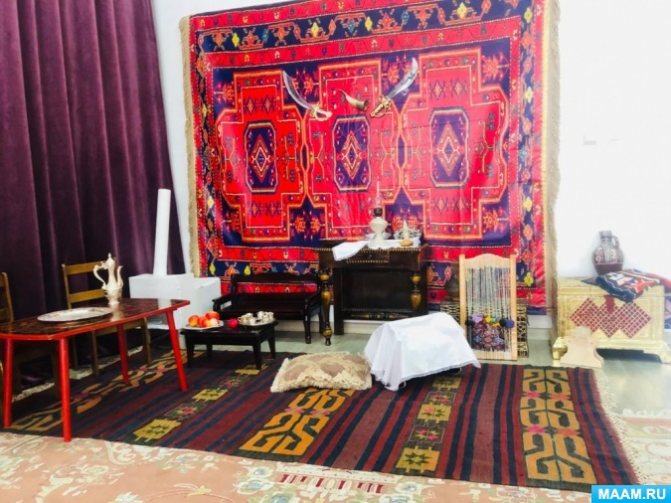
Topic: “Culture and tradition of the peoples of Dagestan” Goal: To form and expand knowledge about your region, folk crafts and craftsmen of Dagestan. Objectives: Develop speech and creative abilities. To develop cognitive interest through introducing children to handicrafts.
Game-dramatization based on the fairy tale “Turnip” for children of primary preschool age Game-dramatization based on the fairy tale “Turnip” for children of primary preschool age Teacher of the 1st category Khanieva F.O. 2021 Game-dramatization based on the fairy tale “Turnip” for children of primary preschool age Goal: Development of the child’s emotional sphere. Objectives: Educational: Continue to introduce.
Source
Working with preschoolers on staging a play. Methodological recommendations
The methodological recommendations include the main stages of working with preschoolers on staging a play and developing scripts for performances.
The recommendations are addressed to the heads of theater associations and additional education teachers.
Working with preschoolers on staging a play
In modern society, the social prestige of intelligence and scientific knowledge has increased. Associated with this is the desire to give children knowledge, to teach them to read, write and count, and not the ability to feel, think and create.
There is an important problem that worries teachers. According to data, during the period of a child’s psychological adaptation to school, 69% of first-graders experience fears, breakdowns, and lethargy, while others, on the contrary, become loose and fussy, lack voluntary behavior skills, and have insufficiently developed memory and attention. The shortest way to emotionally liberate a child, relieve tension, teach feelings and artistic imagination is the path through play, fantasy, and writing. Theatrical activities can provide all this.
It is dramatization “based on an action performed by the child himself that most closely, effectively and directly connects artistic creativity with personal experiences.” (L.S. Vygotsky).
Creating a play with children is a very exciting and rewarding activity. Joint creative activity involves even insufficiently active children in the production process, helping them overcome shyness and inhibition.
When preparing for a performance, try to follow a few basic rules:
- do not overload children;
- do not impose your opinion;
- provide all children with the opportunity to try themselves in different roles.
Children's first meeting with a play or dramatization should be emotionally rich in order to awaken interest in the work ahead. As a rule, the material for stage implementation is fairy tales, which provide “an unusually bright, broad, multi-valued image of the world.” The world of a fairy tale with its wonders and secrets, adventures and transformations is very close to a child. A fairy tale awakens in children compassion, a desire to understand another person, a sense of complicity, justice, a desire to do good and fight evil.
When choosing material for dramatization, take into account the age capabilities, knowledge and skills of children, but at the same time you need to enrich their life experience, awaken interest in new knowledge, and expand their creative capabilities.
The Kuklyandiya theater association has been open to boys and girls since 2003. At first these were teenagers and high school students. Since 2006, the team has been replenished with younger schoolchildren, and since 2009, the team has expanded with preschool children. In this methodological recommendation, I would like to pay attention to the main stages of working with preschoolers on staging a play or dramatization.
The main stages of working on the performance:
- Selecting a play and discussing it with children.
- Dividing the play into episodes and retelling them for children.
- Work on episodes in the form of sketches with improvised text.
- Search for an image (defining the character of the hero, manner of moving, speaking).
- Search for mise-en-scène (musical and plastic solutions for episodes, staging dances). You can create sketches of scenery and costumes with your children.
- Work on the text: proposed circumstances and motive for the characters’ behavior.
- Work on the expressiveness of speech and the authenticity of behavior in public conditions, consolidating individual mise-en-scenes.
- Rehearsals based on paintings with elements of scenery and props (possibly conditional), with musical accompaniment.
- Rehearsal of the entire play - run-through (scenery, props, costume).
- Premiere of the play. Discussion.
- Reruns. Preparing an album with photographs.
The first stage of working on a play is related to its selection. When preparing dramatizations based on folk and original fairy tales, you can have a conversation about the life and way of life of people of that time (what they dressed in, what they ate, how they communicated, what customs they observed). Listening to music, artistic illustration. You can watch films, they help you feel the atmosphere of fabulous events. And it broadens your horizons. Activates cognitive interest.
It is useful for the development of imagination, the ability to fantasize, to invite children to compose the lives of the characters before the play begins (i.e., a fragment of life), helping with a variety of leading questions. Thus, we unobtrusively lead children to the ability to analyze and search for a character’s image.
The second stage involves dividing the play into episodes (pieces). Children retell each episode, complementing each other, and come up with a name.
The third stage is working on individual episodes in the form of sketches with improvised text. At first, the most active children become participants, but we must strive, without forcing, to involve all members of the team in this process. From the beginning, children are hampered by a relatively small vocabulary, which makes it difficult to conduct a dialogue, but feeling the support (hint) of the teacher, children begin to act more naturally and confidently, and their speech becomes more varied and expressive.
The fourth stage is the search for an image, the work is first built as a conversation; discussion of the character of the hero, manner of speaking, moving, We listen to all the options, who thinks what? Why? For what? etc.
All children take part in the discussion, but the teacher’s task is to easily lead to the right decision, explaining why and how. Next, we come up with plastic sketches (gait, manner) and demonstrate them. At this stage, you have to talk a lot about the actor's work and the role. That there are no bad roles. Very often children do not want to play negative characters, so it is necessary to explain to children that the actor’s task is to show these negative character traits and behavior of the hero for moral purposes. And one more technique that you can use is to look for positive qualities in a negative character, and negative qualities in a positive one.
The fifth stage is the search for mise-en-scène. Creation of sketches of scenery and costumes.
Mise-en-scene is the placement of actors, things, various things (props, decoration elements) on the stage at certain moments of the performance. At this stage, young (already) actors learn to act . The teacher’s task is to help find the necessary (according to the logic of the action) gesture, movement, action and lead the child to this action, so that he can really live through some moment so that the movement, action is alive and justified, and not imposed by an adult. We lead the child to this, based specifically on his life experience, analyzing his life situations, and what would you do..., if...? and how would you say... if...?). So, as you can see, at this stage children are faced with Stanislavsky’s “magical: if…”, and this leads to the ability to transform.
Also at this stage, children are introduced to the musical works that will be performed in the performance. And bright musical images help children find the appropriate plastic solution; at first they simply improvise to the music, then move, turning into a specific character.
At the same time, they learn to create sketches, make drawings of individual paintings, images according to a creative plan, selecting colors in accordance with their imagination.
The sixth stage is a gradual transition to the text of the play. During rehearsals, the same passage is repeated by different performers many times, which allows children to quickly learn almost all the roles. During this period, the proposed circumstances of each episode are clarified (where? when? at what time? why? why?) and the motives for the behavior of each character are emphasized (for what? for what purpose?)
The seventh stage begins work on the role. Already knowing that, based on personal emotional experience and memory, the child remembers a situation in his life when he experienced feelings similar to those of the characters in the play. Do not impose the logic of another person’s actions on young actors. Children can propose the most successful, in their opinion, invented mise-en-scène and we consolidate them.
At this stage, achieve expressiveness and clarity of speech, identify the speech characteristics of the characters. Each has their own style (smoothly, drawing out words, another - very quickly, emotionally, a third - slowly, confidently, etc.)
The eighth stage is rehearsal for paintings in different compositions. During rehearsal, make sure that children do not repeat the poses, gestures, and intonations of other performers, but look for their own variations. Learn to place yourself on the stage (logically), without getting confused, without overlapping each other (the law of the stage). Any discovery, a new successful solution should be celebrated and encouraged, taught not to be afraid, but to skillfully work with props, play with the scenery, because the main thing on stage is the action.
The ninth stage is the shortest in time. During this period, rehearsals of the entire play take place. If before at rehearsals some of the scenery and props were conventional, now we use props, scenery, and costumes prepared for the performance, which help in creating the image.
Rehearsals are accompanied by musical accompaniment, the tempo of the performance is specified, the length of individual scenes or, conversely, excessive haste and crumpledness. Assign responsibilities in preparing props and changing scenery.
The tenth stage - the premiere of the performance, is also a dress rehearsal because The first viewer comes to the premiere.
A premiere is always excitement, bustle, and, of course, an upbeat, festive mood. In practice, children begin to understand what the collective nature of theatrical art is, how the success of the performance depends on the attention and responsibility of each performer (prop master, sound engineer, prop man, costume designer, etc.). Applause!
There is no point in holding a discussion immediately after the presentation. Young actors are still too excited and will not be able to evaluate their successes and failures. But the next day, in a conversation, you can find out how critically they are able to treat their own performance by answering questions about what was good and what was not, children learn to evaluate sincerity and truthfulness on stage, note the expressiveness and resourcefulness of behavior on stage, noting expressiveness and resourcefulness of individual performers.
And the teacher’s task is to direct the conversation in the right direction with his questions, trying to point out the main mistakes and shortcomings, but at the same time praise and note the successful and interesting moments of the speech.
And the final stage is reruns of the performance. The statement that children get tired of playing the same thing over and over again is incorrect. This will get boring if everything in the play is programmed and the young actors only blindly carry out the director’s will. And if children understand what they should do on stage, then try to act differently each time, then this is already an element of creative improvisation. And this is the most precious thing for a teacher, as for the leader of a theater group, i.e. The task that I set for myself has been completed - to reveal a creative individuality (to teach me to look for my own expressive means, and not to imitate others), capable of authentically, organically acting in public conditions (stage).
Below are the developments of scripts for various performances.
The full version of the work is available.
Summary of educational activities for young children “Theatrical display of the fairy tale “Teremok”
Olya Elizarova
Summary of educational activities for young children “Theatrical display of the fairy tale “Teremok”
Summary of educational activities for young children theatrical performance of the fairy tale " Teremok "
(edited by M. Bulatov)
Types of children's activities: gaming, communicative, cognitive-research, productive, perception of fiction.
Goals: repeat the content of the Russian folk tale “ Teremok ”
processed by M. Bulatov;
help remember the fairy tale , develop the ability to monitor the actions of the teacher, involve children in staging the fairy tale ; activate speech; evoke a desire to reproduce dialogues between fairy-tale characters ;
consolidate the ability to work with plasticine, roll plasticine between your palms with straight movements, and admire the finished product. Contents of organized children's
1. Organizational moment.
Children sit on the carpet and get ready to listen to a fairy tale . Decorations for a theatrical performance of the fairy tale “ Teremok ”
, exhibits figures of the characters of the performance.
Educator. Today we will remember a fairy tale that I recently read to you. Look at the heroes of this fairy tale and tell me what it is called. ( Children's )
course , this
is Teremok .
Let's tell it together.
2. Main part. Telling a tale .
The teacher tells the fairy tale " Teremok "
, displays character figures on the table during the course of the action and encourages
children to name its characters , complete individual phrases, words, onomatopoeia for animals, and tell what they are doing.
- Who found the tower ? (Little mouse.)
- How did the mouse run across the field? (Children take the toy and show it .)
- Do you know how a mouse squeaks? (Children say “Pee-pee-pee.”
.)
- Who was the second to gallop to the tower ? (Frog frog.)
- Show me how the frog jumped? (Children take the toy and show it .)
- How does a frog talk? (Children say “Kwa-kwa-kwa.”
.)
- How did the bunny gallop? (Children take the toy and show it .)
- Who found the tower ? (Fox-sister.)
- How does she run? (Children take the toy and show it .)
— Did the animals live together? ( Children's .)
In the evenings they enjoyed getting together, singing songs and dancing.
This is how fun the animals lived.
- Who heard the songs and came to the tower ? (The bear is clubfooted.)
- What did he do? ( I broke .)
Yes, now my friends will have to build a new little house .
Physical school
The teacher invites the children to show how a mouse runs, a frog jumps, a bunny jumps, a fox and a wolf run, and a clumsy bear walks. Children can pronounce onomatopoeia while doing exercises.
3. Modeling sticks for the roof.
“If each of you makes one stick, then the animals will have just enough to make a roof.” Let's hurry up, otherwise it will suddenly start to rain. Get to work.
Children begin to sculpt, the teacher controls the work methods during the sculpting process, and helps children who have difficulty completing the task.
The fashioned products are laid out by children on boards. The teacher places the sticks one by one.
Educator. Look, like this, log to log, and we will have a beautiful roof. Admire her.
Familiarization with fiction in the second junior group. Lesson summary “Showing the fairy tale “Three Bears”” Topic: Showing the fairy tale “Three Bears” Purpose: to develop imagination when familiarizing yourself with fiction. Objectives: 1. Familiarization with.
"Teremok". Abstract of educational activities for children of the early development group. "Teremok". Abstract of educational activities for children of the early development group. Topic: “Teremok” Goal: Further development of perception of the figurative content of music.
Photo report “Parents showing the Russian folk tale “Teremok”” In our kindergarten, for children of the second youngest group, parents showed the Russian folk tale “Teremok”. They took an active part in the theatrical performance. Photo report: “Demonstration of the Russian folk tale “Teremok” by parents for children of the first junior group” On April 12, a performance based on the Russian folk tale “Teremok” took place for the children of the “Polyanka” group as part of the theater week. Parents of the group. Photo report “Theater for children.” Showing fairy tales for middle and older children PHOTO REPORT. "THEATRE FOR CHILDREN". Our town is provincial, small, northern. It's rare when real professional artists come to us.
Interactive presentation game “Teremok” for children of early preschool age Goal: To develop children’s interest in interactive games. Objectives: • Expand children's knowledge about fairy tales. • Develop cognitive processes (voluntary.
Source
Scenario of the fairy tale "Kolobok"
Characters:
Kolobok Grandma Grandfather Wolf Fox Hare Bear Storyteller
Act 1
On the stage there is a wooden house, in the background there is a forest. Grandfather and grandmother are sitting near the house.
Narrator: Once upon a time there lived a grandfather and grandmother. They didn’t grieve, but lived modestly. Grandfather wanted to eat, and he told his little wife.
Grandfather: Grandma, and grandma. Prepare something to eat, it's almost lunchtime. You should bake a bun.
Grandma: How can I bake it for you if there is no flour in the house?
Grandfather: Scratch the bottom of the barrel, look better. Look, it looks like a small bun.
Grandma gets up and goes into the house.
Turnip: Grandma started collecting flour from everywhere, and ended up collecting a couple of handfuls. I kneaded the dough and got a bun. The baked bun came out beautifully and smelled delicious. The grandmother put it on the windowsill to cool down. And the bun took it and jumped into the street!
Act 2
Kolobok appears on the stage, skips along the path and hums.
Kolobok: They scraped me up and baked me in a hot oven. I left my grandfather and left my grandmother!
The Hare comes out to meet Kolobok.
Hare: Mmm, what a fragrant bun friend! I will eat you!
Kolobok: Stop, oblique! Do you want me to sing you a song? They scraped me up and baked me in a hot oven. I left my grandfather and left my grandmother! And I’ll leave you, Hare!
Narrator: And Kolobok rolled further along the path past the Hare.
Kolobok runs further, and the Bear comes out to meet him.
Bear: Chubby little bun! I will eat you!
Kolobok: Stop, clubfoot! Do you want me to sing you a song? They scraped me up and baked me in a hot oven. I left my grandfather and left my grandmother! And I’ll leave you, Bear!
Narrator: And Kolobok rolled further along the path past the Bear.
Kolobok runs further, and the Wolf comes out to meet him.
Wolf: Ruddy barrel, delicious barrel! I will eat you!
Kolobok: Stop, gray one! Do you want me to sing you a song? They scraped me up and baked me in a hot oven. I left my grandfather and left my grandmother! And I will leave you, gray Wolf!
Narrator: And Kolobok rolled further along the path past the Wolf.
Kolobok runs further, and the Fox comes out to meet him.
Fox: Who is this fragrant, so tasty? I will eat you!
Kolobok: They scraped me up and baked me in a hot oven. I left my grandfather and left my grandmother! And I left the sideways Hare, and I left the clubfooted Bear, and I left the gray Wolf, and I left you, red Fox!
Fox: Little Kolobok, my friend, I’m old, I can’t hear well, come closer and sing your wonderful song again, I really want to listen to it.
Narrator: The naive Kolobok rolled closer, delighted that someone liked his song so much.
Kolobok: They scraped me up, baked me in a hot oven...
Narrator: And the cunning Fox took it and ate it! And the moral here is: don’t trust strangers and don’t be boastful!
Theatrical screening of the fairy tale “Teremok” (photo report) for children of the second junior group
Larisa Gudkova
Theatrical screening of the fairy tale “Teremok” (photo report) for children of the second junior group
Municipal state preschool educational institution Paninsky kindergarten of general developmental type
Theatrical display of the fairy tale “
Teremok ” ( photo report ) for children of the second junior group
Integration of educational areas: “Communication”
,
“Cognition”
,
“Socialization”
.
Goal: development of children's creative abilities through theatrical activities .
Objectives: continue to develop in children the ability to dramatize a familiar fairy tale , improve the ability to convey the emotional state of heroes, develop dialogical speech, cultivate a love for folk art, Russian folk tales , induce a desire in children to speak front of children in a certain sequence, cultivate friendship, camaraderie, and the ability to act agreed, develop acting skills in children, teach them to play the role of animals (mouse, frog, hare, fox, wolf, bear)
.
Dramatization of the Russian folk tale “Teremok” for the second younger group Scenario for the Russian folk tale “Teremok”. Prepare tickets for spectators. Children enter the hall. They are met by a teacher-storyteller. WITH.
Photo report of observation with children of the second junior group Topic: “Golden autumn has come to visit us.” Goal: to show children the variety of colors of golden autumn. Develop speech, attention, education. Familiarization with fiction in the second junior group. Open lesson “Display of the fairy tale “The Wolf and the Seven Little Goats”” Purpose: To develop imagination when familiarizing yourself with fiction. Objectives: 1. Familiarization with the Russian folk tale “Wolf I.
Summary of speech therapy event. Showing the fairy tale to children of the senior group “The Sure Remedy” (based on the cartoon “The Sure Remedy” 1982). Summary of a speech therapy event Speech development for children in the senior preparatory group.
Scenario for the second younger group. Dramatization of the fairy tale "Teremok" Purpose: Formation of children's creative abilities. Objectives: 1. Teach students to improvise the simplest movements, imitative movements. Theatrical activities in the second junior group. Screening of the fairy tale “Once upon a time there lived a spider” (photo report) “The theater is a magical world. He gives lessons in beauty, morality and ethics. And the richer they are, the more successful the development of the spiritual world of children.” Theatrical production with children of the second youngest group based on the Russian folk tale “Teremok” MUNICIPAL BUDGETARY PRESCHOOL EDUCATIONAL INSTITUTION “ZYKOVSKY KINDERGARTEN” Theatrical production with children 2 younger.
Theatrical show of the fairy tale “Teremok” Theatrical show of the fairy tale “Teremok” (arranged by M. Bulatov). A house for animals. Goal: to introduce children to the new Russian folk music.
Theatrical performance of the Russian folk tale “Teremok” (photo report) Theater is an assistant in raising children. Theater stimulates the child’s activity, has a huge emotional impact, and promotes development.
Source
Entertainment on the topic: Fairy tales in kindergarten. Senior group
Entertainment scenario “Fairy tales walk around the world” in the senior group.
Author: Vitskova Marina Viktorovna, teacher of the MBDOU “Kindergarten “Golden Fish” of the Astrakhan region, Chernoyarsk district.
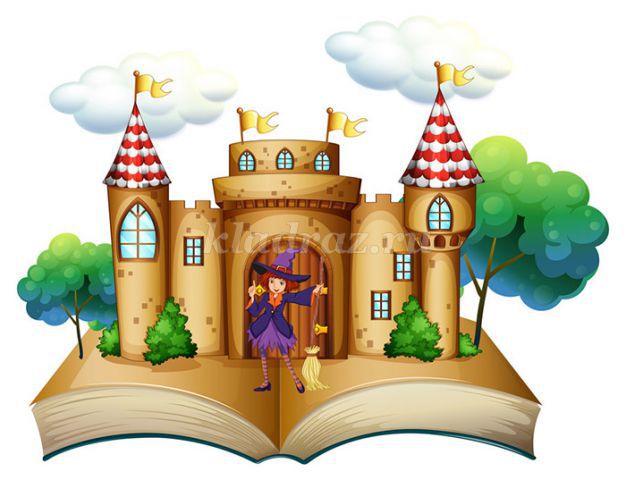
Learn to answer questions with complete answers. Progress of the entertainment
Educator “We reached for the sun…. They took the rays.. They pressed them to the heart, gave them to each other and smiled!” There's a knock on the door. Educator : Guys, someone came to us, I’ll go and have a look. (goes out the door). Educator: The postman came, he brought us this strange letter. On it is our address: Kindergarten “Goldfish” for the senior group “Sunny”. Do you want to know what is written in this letter? Children: Yes! The teacher reads the letter. Hello dear guys! "Hello guys! The heroes of a fairyland are writing to you. We live in a certain kingdom in the Thirtieth State. We experienced great grief. The evil fairy has stolen all the fairy tales and will return them to us only when we complete all her tasks. Dear children, you won’t refuse our request, will you? Educator: Guys, won't we refuse our heroes? Let's help them bring back their fairy tales? Children: Of course, we will help. Educator: Fairy tales walk around the world, harnessing the night to a carriage. Fairy tales live in the clearings, Wandering in the mists at dawn. Educator: Do you like fairy tales? Children: Yes, we love it! Educator: The heroes of a fairy-tale land sent us their pictures. But first guess the riddles and then you will see them. Puzzles. He treats small children, He treats birds and animals, The Good Doctor looks through his glasses... (Aibolit) Mixed with sour cream, Cold at the window, Round side, ruddy side Rolled... (Kolobok) The fat man lives on the roof, He flies higher than everyone else. (Carlson) She is beautiful and sweet, and her name comes from the word “ash.” (Cinderella) The nose is round, with a snout, It is convenient for them to dig in the ground, The tail is small with a hook, Instead of shoes - hooves. Three of them - and how similar the friendly Brothers are. Guess without a hint, who are the heroes of this fairy tale? (The Three Little Pigs) Near the forest, At the edge of the forest, Three of them live in a hut. There are three chairs and three mugs, three beds, three pillows. Guess without a hint, who are the heroes of this fairy tale? (Three Bears) Grandmother loved the girl very much, and gave her a red cap. The girl forgot her name. Well, tell me her name! (Little Red Riding Hood) His father had a strange boy, Unusual, wooden, On the ground and under the water Looking for a golden key, Sticking his long nose everywhere... Who is it?.. (Pinocchio) He was baked from flour, Mixed with sour cream. He was chilling at the window, he (rolled) along the path. He was cheerful, he was brave, and on the way he sang a song. A little bunny wanted to eat him, a gray wolf and a brown (bear) And when the baby met a red (fox) in the forest, he couldn’t get away from her. What kind of fairy tale? (“Kolobok”). Teacher (shows answers). Educator: All the riddles were guessed and all the heroes were named. Educator: Children, do you like fairy tales? Children: Yes, we love it very much. Do your parents read fairy tales to you? What fairy tales are read to you at home? (Children's answers). Educator: Do you know who comes up with fairy tales? Children: Fairy tales are invented by storytellers, people. Educator: What is unusual in fairy tales? Children: Animals, insects talk, heroes who don’t really exist. Educator: Now let’s play, guys. The game is being played: “Dress up Cinderella.” Divide the children into groups and distribute cards with pictures to each group: forest, garden, lake, sea. Ask the children to draw some fairy-tale decorations, a dress or shoes for Cinderella from the gifts of the forest, field, lake, or sea. Based on each other's drawings, children guess what this or that decoration is made of or this or that dress is sewn. The children's drawings are used to create an exhibition: “Dressing up Cinderella.” Educator : Well done, you completed the task correctly. Now let's rest a little and do a warm-up. Finger gymnastics “The Three Little Pigs” is being carried out. Once upon a time there were little pigs (we clench and unclench our fists) In a clearing by the river. (show palms) Early in the morning we woke up (circular movements with our fists) We washed our snouts (we rub our nose with our index fingers) We washed our ears and hooves. (we run our palms over our ears, then we rub our palms together) Oh, and warm water! (we put our palms in front of us) Educator: Guys, I want to play one more game with you. The game is being played: “Name the fairy tale.”
I want to check how well you know fairy tales.
Look at the screen, you need to name the fairy tale that is depicted here. (On the screen there are pictures from fairy tales: Khavroshechka, Puss in Boots, Little Red Riding Hood, The Ugly Duckling, Pinocchio. A fairy sorceress enters the music room to the music.
Fairy (adult) in a suit: You guys did a great job with my tasks, and I’m freeing everyone heroes of fairy tales. Let them return to their fairy tales and make you happy. And I also want to give you this big, wonderful book “In the World of Fairy Tales” as a souvenir, so that you love them and listen with interest. Well, it’s time for me to go back. Goodbye!
The song “There are many fairy tales in the world” sounds. The children leave the hall.
We recommend watching:
Competition of experts in the senior group of kindergarten on the topic: Fairy tales. Leisure time for children 5-9 years old on the topic: Fairy tales. Scenario Crossword puzzle with answers for children 5-9 years old based on fairy tales Scenario for physical education in the senior group of kindergarten
Similar articles:
Theatrical performances for children of senior preschool age (by role)
Dramatization based on Chukovsky’s fairy tale “Confusion” for children 5-6 years old
A dramatization of the fairy tale for children of the senior group “Winter Hut of Animals.” Scenario
Fun for the older group. Ditties
A dramatization of a fairy tale about a grandmother for older children
Scenario of theatrical activities for children of the middle group. Screening of the fairy tale “Teremok”
Irina Sidoryako
Scenario of theatrical activities for children of the middle group. Screening of the fairy tale “Teremok”
Scenario of theatrical activities for children of the middle group
screening of the Russian folk tale " Teremok "
Goal: Development of communication skills through
theatrical activities.
1. Develop artistic and creative skills;
2. Unleash the creative potential of children by involving them in theatrical performances ;
3. Development of communication skills during the theatricalization of a fairy tale ;
4. Learn to play the role of animals (mouse, hare, fox, frog, bear)
Characters: presenter - adult. Children: mouse, frog, wolf, bunny, fox, bear.
Theatrical games and dramatization of fairy tales in preparatory groups

In kindergarten, the child is active and cheerful, ready to play and gain knowledge. Theatricalization of a fairy tale in a kindergarten preparatory group is a way of educating children in a playful way. Every year, at a matinee in honor of the New Year or the eighth of March, children dramatize a fairy tale. This is a completely new experience for them. The child does not just listen to or read a literary work, but for a while becomes its main character. This activity promotes the development of speech, memory, and attention.
Why do you need to dramatize a fairy tale in kindergarten?
It is difficult to overestimate the importance of theatrical activities in a preschool educational institution. In the process of learning and showing the production, the child is raised, morally and physically. Children come to kindergarten to join society; they must learn to speak in public, memorize text, and get involved in gaming or work processes. The teacher’s task is to conduct an interesting game, inserting a cognitive element into it and arousing interest among young actors. Dramatizing a fairy tale in a preparatory group helps show children how they can and cannot behave in different situations.

Matinee in kindergarten
Important! Performances in kindergarten are carried out in accordance with the Federal State Educational Standard, according to the approved program. You can choose well-known fairy tales, such as “The Clapping Fly” or “Little Red Riding Hood,” or show your imagination and stage an unusual production.
The easiest way to introduce a preschooler to national culture is through Russian folk art. At the age of 5, children absorb the wisdom and beauty of fairy tales like a sponge, let everything pass through them, and for the first time think about what is good and what is bad.
Another, no less important goal is aesthetic education. Staging Russian folk works allows you to:
Children from the younger group can prepare a fairy tale and role-play it. A New Year's or autumn party is perfect for this. You can also prepare a fairy tale for the holiday for mothers and for the autumn holiday. In general, 3-5 dramatizations can be prepared per year.
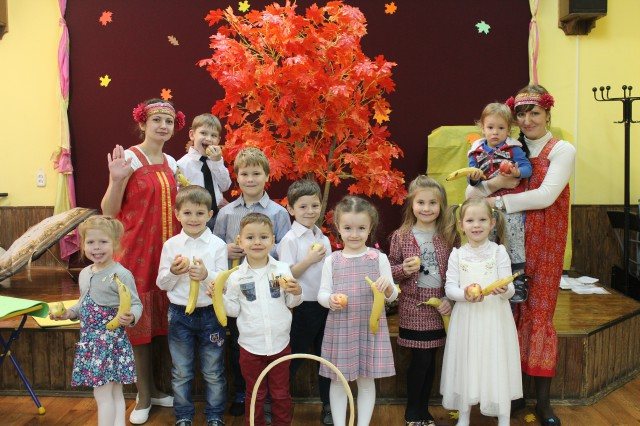
Note! The performance should not last longer than 15 minutes. Children who go to kindergarten are not yet ready for long performances. Dramatization is primarily a game, which means kindergarten students can laugh, dance and chat happily with each other.
What fairy tales are suitable for production in a preparatory group?
Many fairy tales are suitable for dramatization in kindergarten, for example, “Pinocchio”, “How Maya the Doll Baked a Pie”, “Thumbelina”, “Cat’s House”, “Tsokotukha Fly”. The little-known fairy tale “Lada” is also suitable for production. Children get acquainted with different types of works, even those they have never heard of before.
An adult leading character must be identified. In the fairy tale “How Maya the Doll Baked a Pie,” it is the Storyteller who is the first to take the stage and begin to speak. The teacher involves the children in the game with simple words, like these:
"Hello my friends.
I came to visit you.
I'm glad to see you all.
My name is the storyteller.”

The teacher is the main presenter
The fairy tale Thumbelina at first glance may not seem easy to implement, just like the Cat's House, the Turnip, the Wolf and the Seven Little Goats.
cat house
The popular children's fairy tale, familiar to everyone from a very young age, “The Cat's House,” is also suitable for theatricalization in the kindergarten preparatory group.
The scenery for this fairy tale is simple; all you need is a cardboard house and costumes for all the children. For the game you will also need fire extinguishers, but not real ones, but cardboard ones. You can paint regular plastic bottles red.
During the action, children sit on the lawn in front of the house, “drink tea,” and talk. When the music starts, the children sing and dance, and then the performance begins.
The main goal of this production is to teach the child safety rules. Since they will put out a fire in the house using a fire extinguisher, children will quickly remember what this item is and why it is needed.

Cat house in a new way
Teremok
Many children really like the fairy tale “Teremok” and this is an excellent option for dramatization at a matinee.
In this tale you need to distribute several roles:
To stage a fairy tale, five children are chosen to play the main roles, but all the others must also be involved in the performance. The best way is to allocate “spectators” and “participants”, who switch places after a few minutes. Children who watch the performance play along with the main characters, clap, “cry” and laugh with them.
Another version of the dramatization, dividing the fairy tale into two parts: speech and fingers. First, children read the text according to the usual script:
Mouse: “Who lives in the little house? Who lives in a low place?
Teacher: “No one answered. The mouse entered the house and began to live there.”
The frog-frog galloped up to the tower and asked: “Knock, knock. Who lives in the mansion?
When the entire fairy tale has been played out, the rest of the children get up from their chairs and begin to “build a tower”, making various movements. They knock fist against fist, imitating hammering, raise their arms high, showing how big the roof will be, and “call for guests” by waving their arms.
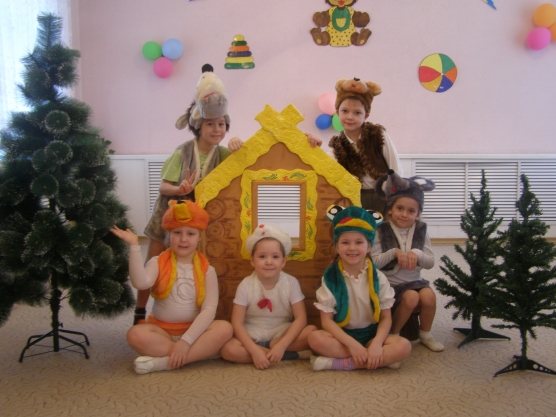
Teremok in kindergarten
To make the game interesting, you need to choose the right scenery. The facade of the tower is made from cardboard; you can also put chairs, covering them with fabric, place a spikelet near the house and a table with cups and a kettle.
Kolobok
In the preparatory group of a kindergarten, you can organize a show of the fairy tale “Kolobok” in a new way. To make the production truly bright and interesting, you need to prepare the props in advance:
The main attribute, without which the performance would not be complete, is a pot of “dough” near the hut. A child can play kolobok; for this they are given a large round ball or a foam toy.
Characters of the fairy tale: the leader (teacher), the old man and the old woman, the bun, the hare, the wolf, the bear, the sly fox.
The words for the production can be taken from a traditional fairy tale, or slightly altered, for example, “I left my grandmother, I left my grandfather,” turns into: “Kolobok, I’m a fidget. They baked me for my grandfather. I'm mixed with sour cream, I'm cold at the window. I left the old people. Jump from the window, and that was it.”

Theatricalization of the fairy tale Kolobok
In order for all the children from the preschool group to be involved in the fairy tale, you need to learn the movements with them. When the presenter says that the grandfather and grandmother are digging a vegetable garden, all children can depict this scene.
Zayushkin's hut
The fairy tale “Zayushkina’s Hut” is suitable for dramatization in a preparatory group at a New Year’s party. The whole group takes part, and the children are given roles: hare, rooster, greedy fox, dog, bull, wolf, bear.
The fox took over Zayushka's house, asking for a visit, and kicked out the owner, but the bunny is brave and seeks help from the animals. The main phrase for a child playing a hare: “How can I not cry? I had a bast hut, and the fox had an ice hut. She asked to spend the night and kicked me out.”
This is followed by a list of animals that have already tried to help the hare and a new attempt to occupy the house.
Note! An activity such as staging a fairy tale in kindergarten, especially the fairy tale about Zayushka’s hut, helps to cultivate empathy in children. At the end, the teacher asks everyone to take pity on the bunny and not offend him, and the children happily do this.
Goat Dereza
The Russian folk tale “The Goat-Dereza” is little known to children, and to introduce the children to it, it is best to stage a theatrical performance. To theatricalize “The Goat-Dereza,” the teacher carries out preliminary work, reads the fairy tale with the children, creates a script for the performance, and prepares the scenery.
For installation you will need:
The teacher begins the speech with simple and understandable words: “Whether close, far, where we don’t know exactly, Grandfather and Grandmother lived.”

Grandfather and Grandmother, goats, granddaughter, bee, bear, wolf and hare come onto the stage. A children's matinee is not an obligation, but a game, but do not forget and aim at an educational moment.
Article DRAGING IN PRE-SCHOOL CHILDREN AS A MEANS OF FORMING THE AESTHETIC SIDE OF PRESCHOOL CHILDREN'S DEVELOPMENT
PERFORMANCE IN PRE-SCHOOL CHILDREN AS A MEANS OF FORMING THE AESTHETIC SIDE OF PRESCHOOL CHILDREN'S DEVELOPMENT
Of course, it is impossible to carry out a full-fledged artistic production in a preschool institution (due to the age of the actors). However, dramatization as a type of creative activity, during which children comprehend the works of art they have heard or read, has a powerful developmental and educational potential.
Translating words into action lies at the heart of theatrical activity. Modern psychology states the fact that for the majority of preschoolers, the leading channel of perception is not the auditory (audio) or even the visual (video) channels, but the kinesthetic one. Staging will help to activate all channels of perception, and therefore provide children with the opportunity to receive information and emotional charge in the most convenient way for them.
Let us pay attention to the fact that dramatization is a complex activity, so it is advisable and effective to do it with older preschoolers.
For a preschooler, dramatization is a new type of activity that requires not only certain abilities, but also skills - to read expressively, move, communicate on stage, take on an image, believe in convention, as well as a number of general mental qualities of the individual: memory, attention, imagination, communication skills.
Theater is always a convention, always a game. And play for a preschooler, as you know, is the main activity, the main way of understanding the world and oneself in this world. Therefore, psychologically, dramatization is perceived as a game of a favorite verbal work.
Let us immediately note that the goal of dramatization in preschool institutions is not the early training of actors, but the development of the general inclinations and abilities of each child, including expressive speech, plasticity, and communication. Dramatizing for children is an exciting game, an opportunity to become one of the characters.
You can dramatize dramatic works written specifically for stage production, epic works, children's play poetry, because these works have a plot, a pronounced action.
The teacher in this game becomes a screenwriter, director, and sometimes an actor at the same time. The task of the child actors is to show what happens to the heroes of the work.
So, staging is carried out in several stages:
1) choice of work;
2) dramatization of the text - translating it into dramatic form (if necessary);
3) introducing children to the original work and creating motivation for dramatizing it;
4) preparing children for dramatization (analysis of the work, establishing cause-and-effect relationships between events, the goals of the characters, the motives of their actions, their feelings, experiences);
5) staging (work on stage speech and stage movement);
6) creation of costumes and scenery (if necessary).
The teacher selects an artistic and verbal work for staging, translates it into dramatic form, distributes roles, explains to all participants the general goal and individual task of the staging, and supervises the preparation. Staging is a time-consuming activity, and if you take into account the age-related psychological characteristics of older preschoolers, it will become obvious that you can do dramatization every day, but no more than 20 minutes. The production is prepared over several weeks, the child begins to live this activity, so its results must be socialized: presented at a matinee, at a New Year's tree, etc. But let’s not forget that at this age the child is interested in the activity itself, and its result is less important than the process.
Let's consider how the dramatization of literary works of different genres and complexity takes place.
Small works that contain pronounced action and events are best suited for dramatization. You cannot stage lyrical works that do not have an external event plot. At the same time, there should not be too many events: children may get confused in their sequence, forget something, or miss something out of excitement.
The most convenient artistic and verbal material for introducing children to dramatization is a folk tale, and not a fairy tale, but either an everyday one, or about animals, or a cumulative one.
We would advise the teacher to start with cumulative fairy tales, i.e. those in which the action from beginning to end is repeated several times and accumulates, for example: “The Cockerel and the Bean Seed,” “Kolobok.” The fact is that it is easier for a small child to remember the plot of such a fairy tale: each episode repeats the previous one, only the character changes. A folk tale does not require memorizing the text - you can speak in your own words, conveying the essence.
When choosing an epic work to dramatize, it is useful to remember that it is more convenient to dramatize epic works, short stories, or individual chapters from literary fairy tales that contain a lot of dialogue. The work should not have many characters (this will create difficulties for the director).
To stage narrative poems, it is necessary to create a script. The fact is that a plot poem cannot be shown on stage in the same way as, for example, a story. The action in a poetic text is compressed, the poet points only to its most important elements: the reader easily unfolds the rest in his imagination, but when trying to show it, the dynamics disappear. Therefore, choosing a subject poem to present on stage is not an easy task. We direct educators to the poetry of D. Kharms, O. Grigoriev, G. Oster, translations from foreign poetry by S.Ya. Marshak. These poems often use dialogue, both indicated by the author and hidden; they have a lot of action. But in any case, translating plot poetry into stage form requires the screenwriter to have a rich imagination and mastery of the conventional language of the theater. Otherwise, he will simply line up the children in a row - and they will take turns pronouncing the poetic text. This form is called literary montage, or literary composition. It also has a right to exist, but is less effective for the overall development of children and less interesting for viewers.
In a work intended for dramatization, there must necessarily be an element of play or outright convention, because claims to stage realistic works by preschoolers are untenable and only foster bad artistic taste.
The main thing is that the work should be interesting to the children themselves, they should want to play it.
